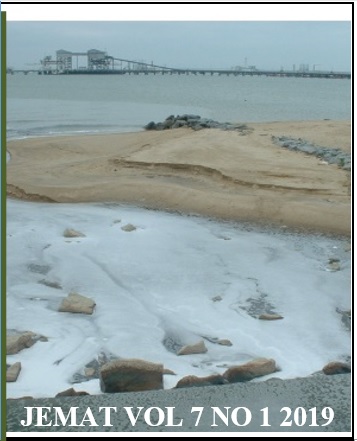The Application of Crude Ginger Protease as an Inhibitive Assay for Heavy Metals
DOI:
https://doi.org/10.54987/jemat.v7i1.472Keywords:
inhibitive assay; ginger protease; heavy metals; Coomassie assay; mercuryAbstract
In this work, a novel source of protease for the bioassay of heavy metals has been developed using proteases extracted from ginger. The result shows that the optimum protease activity was reached at 1 mg/mL protein concentration of the ginger protease. The optimum casein concentration toward crude ginger protease activity was 1.75 mg/mL. The most suitable pH for protease from crude ginger protease was within the range from pH 5.0 to 7.0. The proteases exhibited high protease activity in a broad range of temperature from 20 to 60 oC. The optimum incubation time for the enzyme occurred at minute 30. Among the six heavy metals tested, only three heavy metals inhibited proteolytic activity of ginger crude with an inhibition more than 30% at 1 mg/L. The calculated LC50 for mercury, copper and silver were, 0.182, (95%, confidence interval (C.I.) 0.134 to 0.283), 0.071, (95% C.I. of 0.056 to 0.096), 0.054, (95% C.I. of 0.039 to 0.085), respectively. Data on the sensitivity of various proteases to heavy metals shows that the crude ginger protease is comparable in sensitivity for mercury to the achromopeptidase, bromelain, papain assays. The crude ginger protease assay for copper is comparable in sensitivity to the papain assay and appears to be more sensitive than the rest of the assays. For silver, the ginger protease was the most sensitive while other assay methods are either unable or be able to detect higher concentration of silver. The crude proteases extracted from ginger showed a good potential for the development of a rapid, sensitive, and economic inhibitive assay for the biomonitoring of mercury, copper, and silver in the environment.
Downloads
Published
How to Cite
Issue
Section
License
Authors who publish with this journal agree to the following terms:
- Authors retain copyright and grant the journal right of first publication with the work simultaneously licensed under a Creative Commons Attribution License (http://creativecommons.org/licenses/by/4.0) that allows others to share the work with an acknowledgement of the work's authorship and initial publication in this journal.
- Authors are able to enter into separate, additional contractual arrangements for the non-exclusive distribution of the journal's published version of the work (e.g., post it to an institutional repository or publish it in a book), with an acknowledgement of its initial publication in this journal.
- Authors are permitted and encouraged to post their work online (e.g., in institutional repositories or on their website) prior to and during the submission process, as it can lead to productive exchanges, as well as earlier and greater citation of published work (See The Effect of Open Access).


